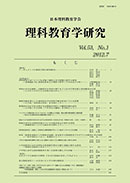Volume 50, Issue 1
Displaying 1-10 of 10 articles from this issue
- |<
- <
- 1
- >
- >|
Original Papers
-
2009Volume 50Issue 1 Pages 1-12
Published: July 10, 2009
Released on J-STAGE: June 30, 2022
Download PDF (1470K) -
2009Volume 50Issue 1 Pages 13-19
Published: July 10, 2009
Released on J-STAGE: June 30, 2022
Download PDF (843K) -
2009Volume 50Issue 1 Pages 21-28
Published: July 10, 2009
Released on J-STAGE: June 30, 2022
Download PDF (894K) -
2009Volume 50Issue 1 Pages 29-34
Published: July 10, 2009
Released on J-STAGE: June 30, 2022
Download PDF (1458K) -
2009Volume 50Issue 1 Pages 35-49
Published: July 10, 2009
Released on J-STAGE: June 30, 2022
Download PDF (3129K) -
Article type: Article
2009Volume 50Issue 1 Pages 51-65
Published: July 10, 2009
Released on J-STAGE: June 30, 2022
Download PDF (2615K) -
2009Volume 50Issue 1 Pages 67-74
Published: July 10, 2009
Released on J-STAGE: June 30, 2022
Download PDF (934K) -
2009Volume 50Issue 1 Pages 75-84
Published: July 10, 2009
Released on J-STAGE: June 30, 2022
Download PDF (1216K) -
2009Volume 50Issue 1 Pages 85-92
Published: July 10, 2009
Released on J-STAGE: June 30, 2022
Download PDF (2301K)
Note
-
2009Volume 50Issue 1 Pages 93-104
Published: July 10, 2009
Released on J-STAGE: June 30, 2022
Download PDF (1449K)
- |<
- <
- 1
- >
- >|
